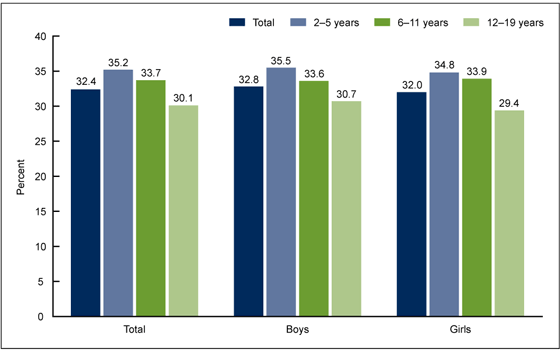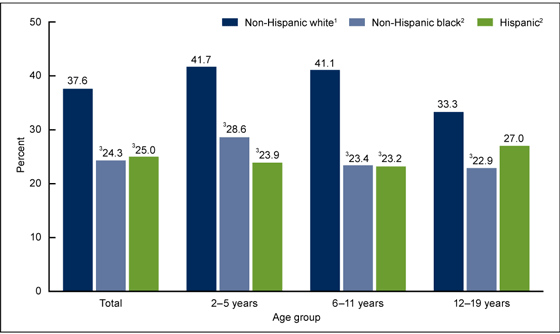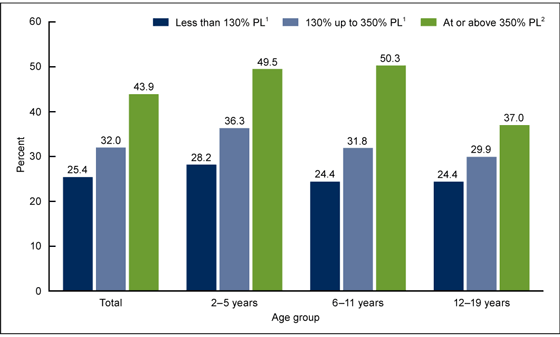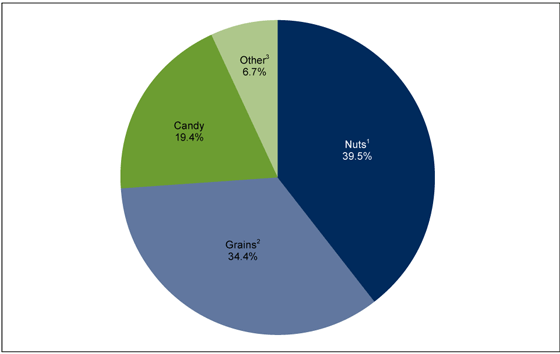Nut Consumption Among U.S. Youth, 2009–2012
NCHS Data Brief No. 238, March 2016
On This Page
- Key findings
- Were there differences by sex and age in the percentage of U.S. youth who consumed nuts on a given day?
- Were there differences by age and race and Hispanic origin in the percentage of U.S. youth who consumed nuts on a given day?
- Were there differences by age and poverty status in the percentage of U.S. youth who consumed nuts on a given day?
- What was the source of nuts consumed during 2009–2012?
- Summary
- Definitions
- Data source and methods
- About the authors
- References
- Suggested citation
Samara Joy Nielsen, Ph.D., M.Div.; Kirsten A. Herrick, Ph.D., M.Sc.; Lara J. Akinbami, M.D.; and Cynthia L. Ogden, Ph.D., M.R.P.
Key findings
Data from the National Health and Nutrition Examination Survey
- During 2009–2012, 32.4% of youth consumed nuts (including seeds and nut butters) on a given day.
- A higher percentage of non-Hispanic white youth (37.6%) than non-Hispanic black (24.3%) or Hispanic (25.0%) youth consumed nuts.
- Almost 44.0% of youth in households at or above 350% of the poverty level consumed nuts, compared with 25.4% of youth in households below 130% of the poverty level.
- Slightly less than 40% of nuts were consumed as a single-item food and not as an ingredient in candy, breads, cakes, cookies, cereals, or other dishes.
Nut consumption has been associated with improved weight status (1,2), nutrient intake (3), and diet quality (4,5) among youth. However, allergies to nuts among children may be increasing (6,7), which may lead to higher vigilance over nut exposure in schools and other public settings (8,9). This data brief examines the percentage of youth consuming nuts, including seeds and nut butters, on a given day. In addition, the source of nuts consumed is examined (i.e., the percentages of nuts consumed as a single-item food and as part of other foods).
Keywords: National Health and Nutrition Examination Survey
Were there differences by sex and age in the percentage of U.S. youth who consumed nuts on a given day?
Approximately one-third of U.S. youth (32.4%) consumed nuts or seeds (referred to as nuts) on a given day (Figure 1). As age increased, the percentage of youth consuming nuts decreased. Among those aged 2–5 years, 35.2% consumed nuts, while among those aged 12–19, 30.1% consumed nuts on a given day during 2009–2012. Similar patterns by age were seen in boys and girls but were not significant. The percentage of youth consuming nuts did not differ between boys and girls in any age group.
Figure 1. Percentage of youth aged 2–19 years who consumed nuts on a given day, by sex and age: United States, 2009–2012
1Significant linear trend by age (p < 0.05).
NOTES: No significant difference was seen between boys and girls. Nuts include seeds and nut butters. Access data table for Figure 1.
SOURCE: CDC/NCHS, National Health and Nutrition Examination Survey.
Were there differences by age and race and Hispanic origin in the percentage of U.S. youth who consumed nuts on a given day?
Nut consumption varied by age and race and Hispanic origin (Figure 2). More non-Hispanic white youth consumed nuts (37.6%) than non-Hispanic black (24.3%) or Hispanic (25.0%) youth. This pattern was seen in each age group. Among youth aged 2–5 years, 41.7% of non-Hispanic white youth, 28.6% of non-Hispanic black youth, and 23.9% of Hispanic youth consumed nuts. Similarly, among youth aged 6–11 years, 41.1% of non-Hispanic white youth, 23.4% of non-Hispanic black youth, and 23.2% of Hispanic youth consumed nuts. By comparison, among older youth aged 12–19 years, 33.3% of non-Hispanic white youth, 22.9% of non-Hispanic black youth, and 27.0% of Hispanic youth consumed nuts (although the Hispanic group was not statistically different from the aged 12–19 non-Hispanic white group).
Among non-Hispanic white youth, those aged 12–19 years had lower consumption (33.3%) than children aged 2–5 (41.7%) and 6–11 (41.1%) years. Among non-Hispanic black and Hispanic youth, no significant differences were seen between the age groups. Specifically, among non-Hispanic black youth, 28.6% of those aged 2–5 years, 23.4% of those aged 6–11 years, and 22.9% of those aged 12–19 years consumed nuts on a given day. Among Hispanic youth, 23.9% of those aged 2–5 years, 23.2% of those aged 6–11 years, and 27.0% of those aged 12–19 years consumed nuts on a given day.
Figure 2. Percentage of youth aged 2–19 years who consumed nuts on a given day, by age and race and Hispanic origin: United States, 2009–2012
1No difference between age groups 2–5 years and 6–11 years; age group 12–19 years is significantly different from other age groups (p < 0.05).
2Age groups not significantly different from one another.
3Significantly different from non-Hispanic white (p < 0.05).
NOTES: Nuts include seeds and nut butters. Access data table for Figure 2.
SOURCE: CDC/NCHS, National Health and Nutrition Examination Survey.
Were there differences by age and poverty status in the percentage of U.S. youth who consumed nuts on a given day?
As income increased, nut consumption increased (Figure 3). Among youth living in households below 130% of the poverty level, 25.4% consumed nuts. Among youth living at 130% up to 350% of the poverty level, 32.0% consumed nuts, and among youth at or above 350% of the poverty level, 43.9% consumed nuts. This pattern was seen within each age group. Among youth aged 2–5 years, 28.2% of those below 130% of the poverty level, 36.3% of those at 130% up to 350% of the poverty level, and 49.5% of those at or above 350% of the poverty level consumed nuts. Similarly, among youth aged 6–11 years, 24.4% of those below 130% of the poverty level, 31.8% of those at 130% up to 350% of the poverty level, and 50.3% of those at or above 350% of the poverty level consumed nuts. Among older youth aged 12–19 years, 24.4% of those below 130% of the poverty level, 29.9% of those at 130% up to 350% of the poverty level, and 37.0% of those at or above 350% of the poverty level consumed nuts.
For youth in households below 130% of the poverty level or at 130% up to 350% of the poverty level, age differences in nut consumption on a given day were not statistically significant. For youth at or above 350% of the poverty level, those aged 2–5 years (49.5%) and 6–11 years (50.3%) had greater nut consumption than youth aged 12–19 years (37.0%).
Figure 3. Percentage of youth aged 2–19 years who consumed nuts on a given day, by age and poverty status: United States, 2009–2012
1Age groups not significantly different from each other.
2No difference between age groups 2–5 years and 6–11 years; age group 12–19 years is significantly different from other age groups (p < 0.05).
NOTES: PL is poverty level. Nuts include seeds and nut butters. Significant linear trend was seen by poverty status (p < 0.001) overall and for each age group. Access data table for Figure 3.
SOURCE: CDC/NCHS, National Health and Nutrition Examination Survey.
What was the source of nuts consumed during 2009–2012?
Approximately 40% of nuts consumed on a given day (39.5%) were consumed as a single-item food and not as an ingredient in candy, breads, cakes, cookies, cereals, or other mixed dishes (Figure 4). About one-third of nuts consumed (34.4%) were part of a grain-based food. Approximately one-fifth of nuts consumed (19.4%) were part of a candy food item. Almost 7% of nuts consumed (6.7%) were from other sources, including ice cream, cheese, and mixed dishes.
Figure 4. Source of nuts consumed on a given day among youth aged 2–19 years: United States, 2009–2012
1Include seeds and nut butters (as a single-item food only).
2Include breads, cakes, cookies, cereals, and nutrition bars.
3Includes ice cream, cheese, and mixed dishes.
NOTE: Access data table for Figure 4.
SOURCE: CDC/NCHS, National Health and Nutrition Examination Survey.
Summary
About one-third of U.S. youth consumed nuts on a given day in 2009–2012. Older youth were less likely to consume nuts than younger youth. More non-Hispanic white than non-Hispanic black or Hispanic youth consumed nuts. More youth living in households at or above 350% of the poverty level consumed nuts than youth in households below 130% poverty or at 130% up to 350% of the poverty level.
Although previous guidance suggested that timing of the introduction of nuts into children’s diets may play a role in allergies, this guidance has recently been revised (10). There is a lack of evidence linking early introduction of nuts to development of allergy (10). This analysis did not include infants under the age of 1 year but did find that consumption of nuts was higher among younger children.
More than one-third of nut consumption among youth (39.5%) occurs as a single-item food (i.e., not as an ingredient in other foods). Nuts are an alternate source of protein (11,12), especially for youth. Nuts are also high in mono- and polyunsaturated fats and fiber, and are a rich source of antioxidants such as selenium and vitamin E. Some nuts, especially walnuts and pumpkin seeds, are good sources of omega-3 fatty acids (13).
Definitions
Nuts and seeds: Refers to almonds, almond butter, almond paste, Brazil nuts, cashews, cashew butter, chestnuts, flax seeds, hazelnuts, macadamia nuts, peanuts, peanut butter, peanut flour, pecans, pine nuts, pistachios, pumpkin seeds, squash seeds, sesame butter (tahini), sesame seeds, sesame paste, sunflower seeds, and walnuts (14,15).
Nut consumer: Any person who reported consuming foods containing nuts, as defined by the U.S. Department of Agriculture (USDA) Food Patterns Equivalents Database nut and seed food group, during the 24-hour recall component of the National Health and Nutrition Examination Survey (NHANES).
Data source and methods
NHANES data for 2009–2012 were used for these analyses. NHANES, conducted by the Centers for Disease Control and Prevention’s National Center for Health Statistics, assesses the health and nutritional status of the civilian noninstitutionalized U.S. population. The survey combines an in-home interview and a standardized physical examination at the NHANES mobile examination center (MEC). For this report, data were collected via an in-person 24-hour dietary recall interview (16) in the MEC. The dietary recall covers intake during the day (24 hours) prior to the standardized physical examination in the MEC. The USDA Food Patterns Equivalents Database (14,15) was used to identify which reported foods were nuts (and seeds) or contained nuts (and seeds).
NHANES includes oversampling to obtain reliable estimates of health and nutritional measures for population subgroups. Day 1 dietary sample weights were used to account for day of the week, differential probabilities of selection, nonresponse, and noncoverage. The standard errors of the percentages were estimated using Taylor series linearization to account for the complex survey sampling design.
Unadjusted prevalence estimates are presented because the objective of this analysis was to show the percentage of the youth population that actually consumed nuts. Differences between groups, and tests for linear trends, were evaluated using a t statistic at the p less than or equal to 0.05 significance level. Statistical analyses were conducted using SAS version 9.3 (SAS Institute, Cary, N.C.) and SUDAAN version 11.0 (RTI International, Research Triangle Park, N.C.).
About the authors
Samara Joy Nielsen, Kirsten A. Herrick, Lara J. Akinbami, and Cynthia L. Ogden are with CDC’s National Center for Health Statistics, Division of Health and Nutrition Examination Surveys.
References
- Moreno JP, Johnston CA, El-Mubasher AA, Papaioannou MA, Tyler C, Gee M, Foreyt JP. Peanut consumption in adolescents is associated with improved weight status. Nutr Res 33(7):552–6. 2013.
- Matthews VL, Wien M, Sabaté J. The risk of child and adolescent overweight is related to types of food consumed. Nutr J 10:71. 2011.
- O’Neil CE, Keast DR, Nicklas TA, Fulgoni VL 3rd. Out-of-hand nut consumption is associated with improved nutrient intake and health risk markers in US children and adults: National Health and Nutrition Examination Survey 1999–2004. Nutr Res 32(3):185–94. 2012.
- King JC, Blumberg J, Ingwersen L, Jenab M, Tucker KL. Tree nuts and peanuts as components of a healthy diet. J Nutr 138(9):1736S–40S. 2008.
- O’Neil CE, Keast DR, Fulgoni VL 3rd, Nicklas TA. Tree nut consumption improves nutrient intake and diet quality in US adults: An analysis of National Health and Nutrition Examination Survey (NHANES) 1999–2004. Asia Pac J Clin Nutr 19(1):142–50. 2010.
- Sicherer SH, Muñoz-Furlong A, Godbold JH, Sampson HA. US prevalence of self-reported peanut, tree nut, and sesame allergy: 11-year follow-up. J Allergy Clin Immunol 125(6):1322–6. 2010.
- Bunyavanich S, Rifas-Shiman SL, Platts-Mills TA, Workman L, Sordillo JE, Gillman MW, et al. Peanut allergy prevalence among school-age children in a US cohort not selected for any disease. J Allergy Clin Immunol 134(3):753–5. 2014.
- Ludman S, Ballabeni P, Eigenmann PA, Wassenberg J. Predicting positive food challenges in children sensitised to peanuts/tree nuts. Pediatr Allergy Immunol 24(3):276–81. 2013.
- Kao L, Bhangoo PS, Roy L, Bird JA. Identification of peanuts and tree nuts: Are allergists smarter than their patients? Ann Allergy Asthma Immunol 111(4):282–5. 2013.
- Greer FR, Sicherer SH, Burks AW, American Academy of Pediatrics Committee on Nutrition, American Academy of Pediatrics Section on Allergy and Immunology. Effects of early nutritional interventions on the development of atopic disease in infants and children: The role of maternal dietary restriction, breastfeeding, timing of introduction of complementary foods, and hydrolyzed formulas. Pediatrics 121(1):183–91. 2008.
- U.S. Department of Agriculture, U.S. Department of Health and Human Services. Scientific report of the 2015 Dietary Guidelines Advisory Committee. 2015.
- U.S. Department of Agriculture, U.S. Department of Health and Human Services. Dietary guidelines for Americans, 2010. 7th ed. Washington, DC: U.S. Government Printing Office.
- U.S. Department of Agriculture, Agricultural Research Service, Nutrient Data Laboratory. USDA National Nutrient Database for standard reference, release 27 (revised). 2015.
- Bowman SA, Clemens JC, Friday JE, Thoerig RC, Moshfegh AJ. Food Patterns Equivalents Database 2011–12: Methodology and user guide. Beltsville, MD: Food Surveys Research Group, Beltsville Human Nutrition Research Center, Agricultural Research Service, U.S. Department of Agriculture. 2014.
- Bowman SA, Clemens JC, Thoerig RC, Friday JE, Shimizu M, Moshfegh AJ. Food Patterns Equivalents Database 2009–10: Methodology and user guide. Beltsville, MD: Food Surveys Research Group, Beltsville Human Nutrition Research Center, Agricultural Research Service, U.S. Department of Agriculture. 2013.
- National Center for Health Statistics. National Health and Nutrition Examination Survey: Questionnaires, datasets, and related documentation.
Suggested citation
Nielsen SJ, Herrick KA, Akinbami LJ, Ogden CL. Nut consumption among U.S. youth, 2009–2012. NCHS data brief, no 238. Hyattsville, MD: National Center for Health Statistics. 2016.
Copyright information
All materials appearing in this report is in the public domain and may be reproduced or copied without permission; citation as to source, however, is appreciated.
National Center for Health Statistics
Charles J. Rothwell, M.S., M.B.A., Director
Nathaniel Schenker, Ph.D., Deputy Director
Jennifer H. Madans, Ph.D., Associate Director for Science
Division of Health and Nutrition Examination Surveys
Kathryn Porter, M.D., M.S., Director
Ryne Paulose-Ram, Ph.D., Associate Director for Science
- Page last reviewed: March 10, 2016
- Page last updated: March 10, 2016
- Content source:


 ShareCompartir
ShareCompartir



